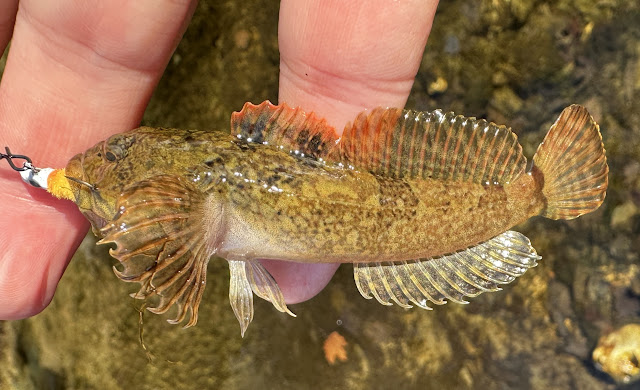***I haven't shared much regarding techniques for quit a while, my recent posts being more about the fish with which I am so enamored. I'm going to start sharing more specifically what I've learned for the various species I've caught.
We all know fish in different waters can behave differently and have different preferences. But I think overall this will give folks who want to try for certain species more info that can hopefully get them started off on the right foot, rather than going blindly. We can all shorten our personal learning curve by first learning from the experience of others.***
This blog post is about Sculpin.
To date, I've caught 3 species, with similar preferences... Ozark Sculpin, Knobfin Sculpin, and Mottled Sculpin. They like being under rocks or next to rocks, with only mild current flowing by. You can often fish these rocks from shore.
It definitely helps if the water is clear enough for sight-fishing....where you can present the fly to an individual fish or spot, and see how they react. I've caught fish that I didn't see first, but the visible fish are your best and easiest targets.
Since they are often found in spring-fed streams, as long as the stream isn't frozen over in Winter, you can probably catch these fish every month of the year.
As Sculpin are often in trout stream-type environments, you can use light trout gear... such as a 5 wt or lighter fly rods, and 2 lb - 4 lb Fluorocarbon tippet is sufficient...probably overkill.
Larger sculpin have big mouths, but smaller ones obviously do not. Size your fly appropriately. I typically use a #10 for the larger sculpins, and a #14 for the smaller ones. I like weighted flies, such as a microjig or other bead-head fly, that will help you get to the bottom to probe between and around larger rocks that Sculpin like to hand around and under. Keep the tail material short, so if the fish tries to eat the fly, it can fit the hook into its mouth. Tiny weighted egg flies could also work. Fly color is less important, but I prefer to use colors that I can see fairly well... such as chartreuse, orange, yellow, pink, white, or even a flashy metallic in gold or silver.
 |
| Size 12 or 14 Microjigs, tied on custom-made heads |
Most fishing for Sculpin is done vertically... straight below your rod tip. Work your fly of choice around the base of the larger rocks. Frequently "bang" the fly on the bottom. This seems to help attract the nearby sculpins to your fly. Sculpins blend in really well with the bottom, so look for any movement near your fly that might be a sculpin turning on it or following it. When your fly disappears, simply lift the sculpin from the water. There's really no opportunity to let the fish fight. It is what it is.
Here's a few pics of Sculpins I've caught while flyfishing:








No comments:
Post a Comment